A bit of a medley, in other words, this post. I hope not too muddled a medley . . .
Your responses to the last few posts on ageing have encouraged me to pursue the theme a bit longer, sporadically or regularly I’m not yet sure. Leaning towards sporadic and random at the moment, and I’d like to be able to fold my thoughts on the subject into posts alongside other interests.
So, today: some examples of recent visible mending, a pertinent quotation . . . and one wee granddaughter anecdote that exemplifies shifted thinking. . .
First, some stitching I recently applied to some wear on my husband’s pea-coat. I’d satin-stitched over the worn edge of the pocket placket a year or so ago without his knowledge, choosing the red embroidery floss and hoping he’d like it, replacing the mended coat in the closet without mentioning anything. Whew! The next time he wore it, he was tickled with the reasonably conservative deployment of whimsy . . .
So that when I discovered a small hole (moth?) near one of the buttons, I felt confident in darning with that same colour.
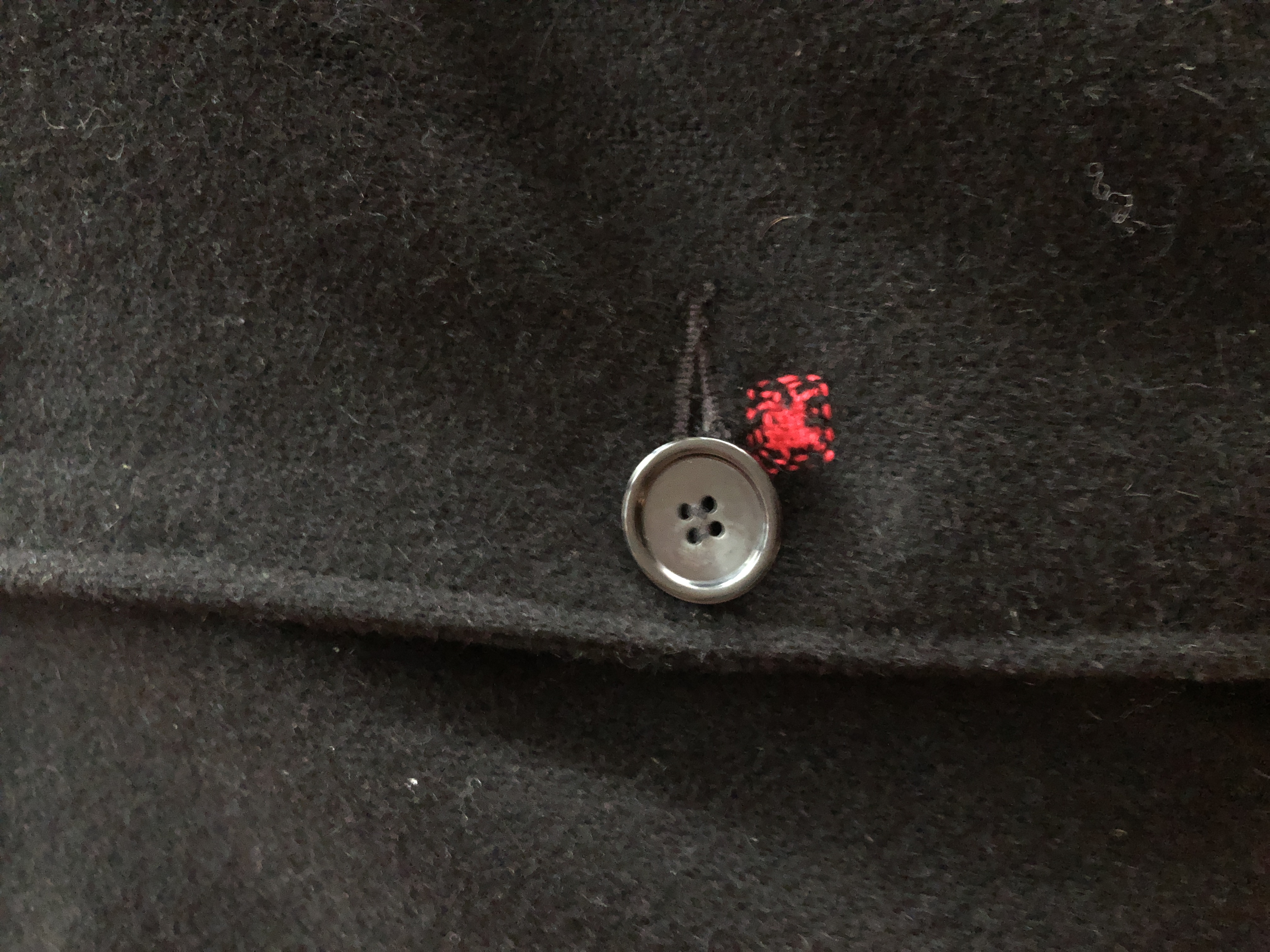
And not only did he express pleasure at this “creative” fix, but he returned from grocery-shopping a few days later to tell me that the cashier had complimented him on it and chatted with him a bit about “visible mending.”
He should be getting a bit nervous, though, and warding off the moths, because I admit to visions of “Paul’s Amazing Technicolour Dream Coat.” (very dated, very amusing, rendition from a production featuring Donny Osmond).
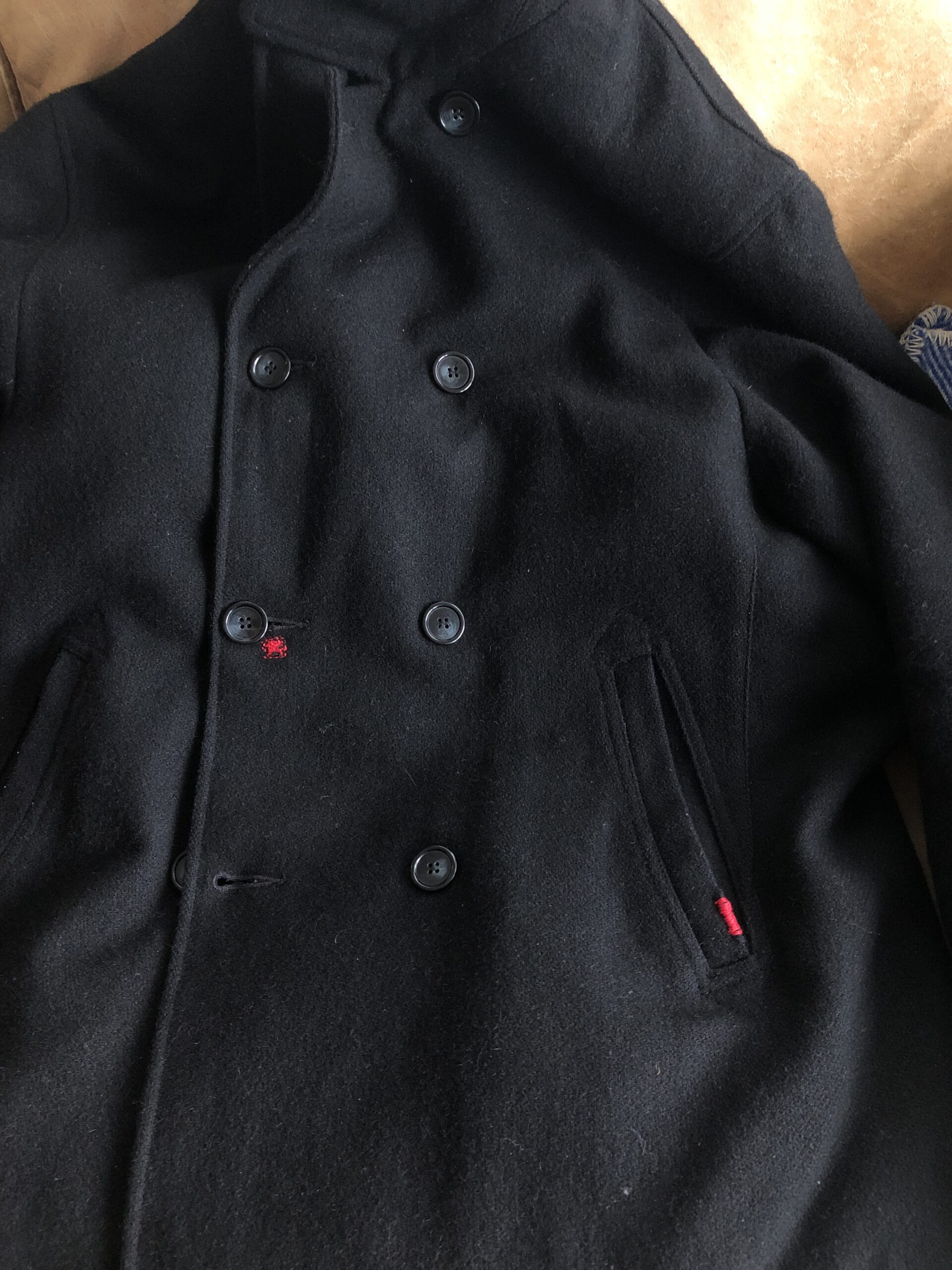
And since we’re chatting about mending old garments creatively . . . let me pivot to consider living old lives creatively . . . and pivot to think about the link between creativity and survival in general. . .
In comments on the last post, a few readers pointed out that the care home Diana Athill had access to was not typical of what most could afford. Indeed, in the first post in this little series I referred (very briefly, admittedly) to the difference income level is likely to make on our old age, particularly on our end-of-life experience. So I want to clarify that I didn’t offer quotations from Athill’s memoirs as a practical recommendation of institutional care for any or all.
Rather, I’m trying to shake up my own thinking a bit, and perhaps some of yours, as a way to broadening possibilities and not being trapped in inherited fears. More on that later, perhaps. I have stories; I’m sure you do as well. But there are other stories, and I think there might be a worthwhile conversation here.
For the moment, however, this quotation from a potent, beautiful, and important memoir Between Two Kingdoms: A Memoir of a Life Interrupted by writer/journalist/advocate Suleika Jaouad, whom Pater and I were fortunate enough to see in person, with her husband Jon Batiste, Grammy-award-winning musician, just a few weeks ago. (Perhaps you’ve seen their moving, inspiring documentary American Symphony, on Netflix — highly recommended!)
Jaouad recounts a decision she makes after years of illness, chemotherapy, isolation, and finally a bone-marrow transplant followed by more isolation, illness, and overall physical weakness. Crushed when a series of attempts at normal life leave her exhausted, nauseous, and in pain, she agrees to try a Hundred-Day Project (daily engagement with a creative project for one hundred consecutive days) with the rest of her family. Looking for inspiration, she reads Frida Kahlo’s diary, and is moved to discover that “Kahlo transformed her confinement into a place incandescent with metaphor and meaning” (p. 108).
And so, she writes,
I decided to reimagine my survival as a creative act. If the chemo sores in my mouth made it too painful to talk, I would find new ways to communicate. As long as I was stuck in bed, my imagination would become the vessel that allowed me to travel beyond the confines of my room. If my body had grown so depleted that I now had only three functional hours each day, I would clarify my priorities and make the most of how I spent the time I had.
With this in mind, I reorganized my bedroom so that everything I needed was within arm’s reach: a small night table littered with pens, notebooks, and paper; a bookshelf filled with my favorite novels and volumes of poetry; a wooden board that I placed atop my knees as a desk. I wrote when I was home, and I wrote each day that I found myself back in the hospital. I wrote until the anger and envy and pain bled dry — until I could no long hear the persistent beeping of monitors, the alarms that constantly went off. I had no way of predicting all the places the Hundred-Day Project would take me, but what I knew, for now, was that I was starting to find my power.
Suleika Jaouad, Between Two Kingdoms, New York: Random House, 2021, p. 109, my emphasis/bolding
Of course, Jaouad is in her mid-20s when she makes this decision, but she is living as close to mortality as many of us will be in our 70s, 80s, 90s. She’s not speaking specifically of a relationship between survival and creativity in terms of old age or end of life, but in their talk both she and Jon Batiste emphasized the crucial importance of creativity to survival in every aspect of our lives.
And such a practical recourse to creativity was what I read in Athill’s memoirs, in her willingness to reconsider a long-held resistance to institutional care. To reframe her erstwhile perception of “sitting and thinking” or “just sitting” as the “pitiable” reality of life in a retirement home, and advising that she has learned “from experience that the state is not necessarily pitiable at all [but can be] rather pleasant.” This shift in perspective is, in itself, a creative move — and, in turn, it renders the “sitting and thinking” as full of creative potential. It confers a sense of agency which might be almost as important as the independence Athill has had to surrender.
I have no idea how my next decade or two will progress, no way of telling now what support I may or may not need to live as fully as possible until my death. But I am increasingly convinced, inspired, and reassured that cultivating my own creativity now in as many ways as practical will stand me in good stead.
So. . . something like “reimagining my old age (even the end of my life, somewhere down the road) as a creative act.” Hmmm, we’ll see. . .
Meanwhile, I’m mending, practicing small transformations. . .
A favourite wool dress, simple, slim-fitting, long-sleeved, darkest navy — reads as black — and chocolate brown. A reminder of a great day spent with an out-of-town friend just months before Covid shut us down, changed our possibilities. We had lunch, I think we sketched together, and we shopped as I hadn’t shopped with a friend for decades.
I remember that the Sales Assistant at COS (where I bought the dress) was very complimentary about our curly grey hair (not quite as popular nor as common a phenomenon before Covid as it became over the next year of shuttered hair salons). Gorgeous! he gushed, a tried-and-true sales technique, I suspected, but between that and my friend’s enthusiastic thumbs-up, the dress came home with me, even though it has no pockets.
But a few weeks ago, having put it on without checking my look too carefully (it’s that kind of dress — one and done, although it does require tights) . . . I looked down while having coffee with a sister and a daughter, and I was surprised by a small peephole about halfway up my thigh.

There was some procrastination, some pondering, and finally I got a small patch from an old pair of black wool socks (machine-knit) — I’ve folded the hem back here, so that you can see the inside of the dress, with patch applied.
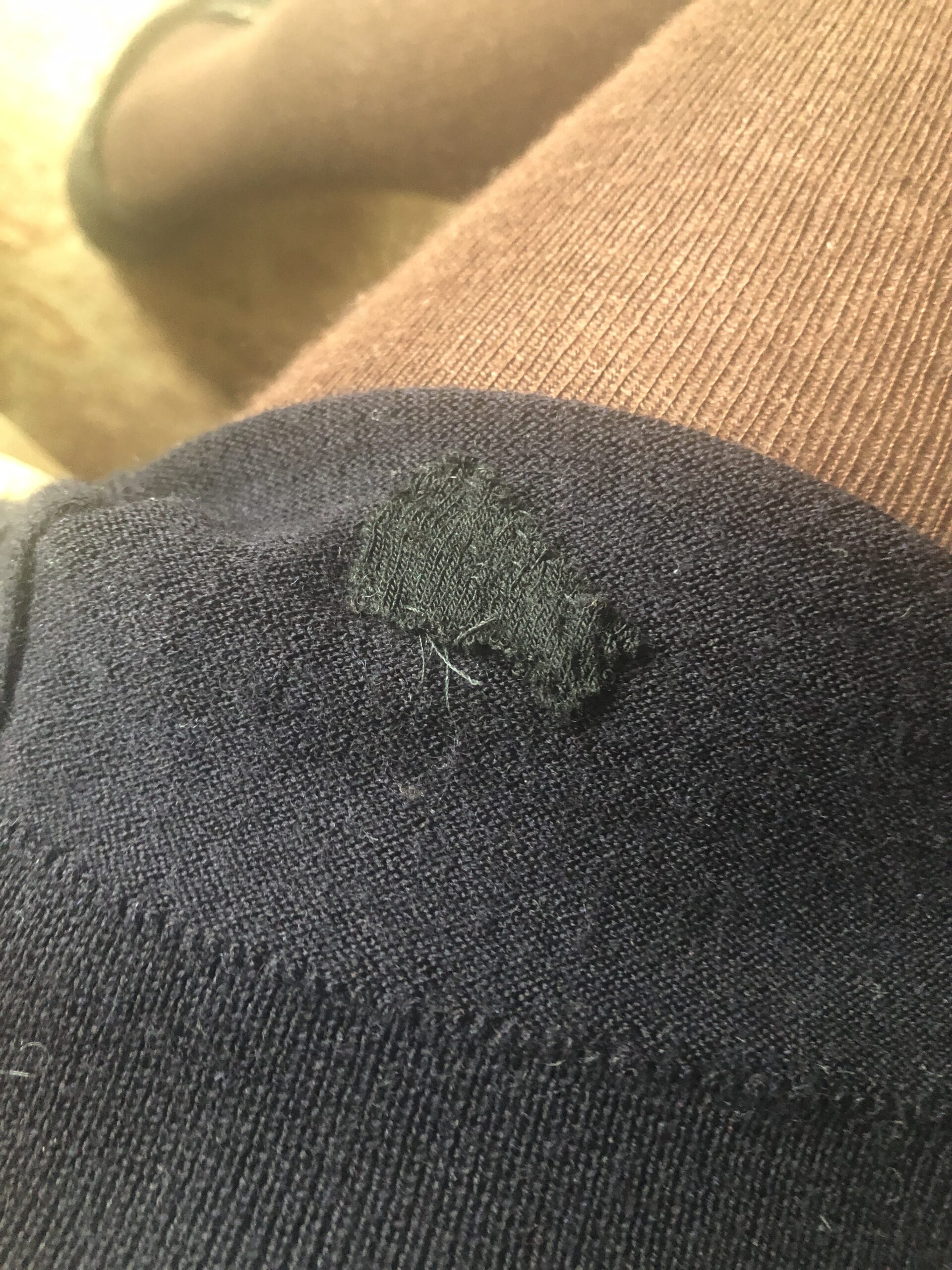
Here’s the outside, the sashiko-inspired stitches which anchor the patch firmly in place.
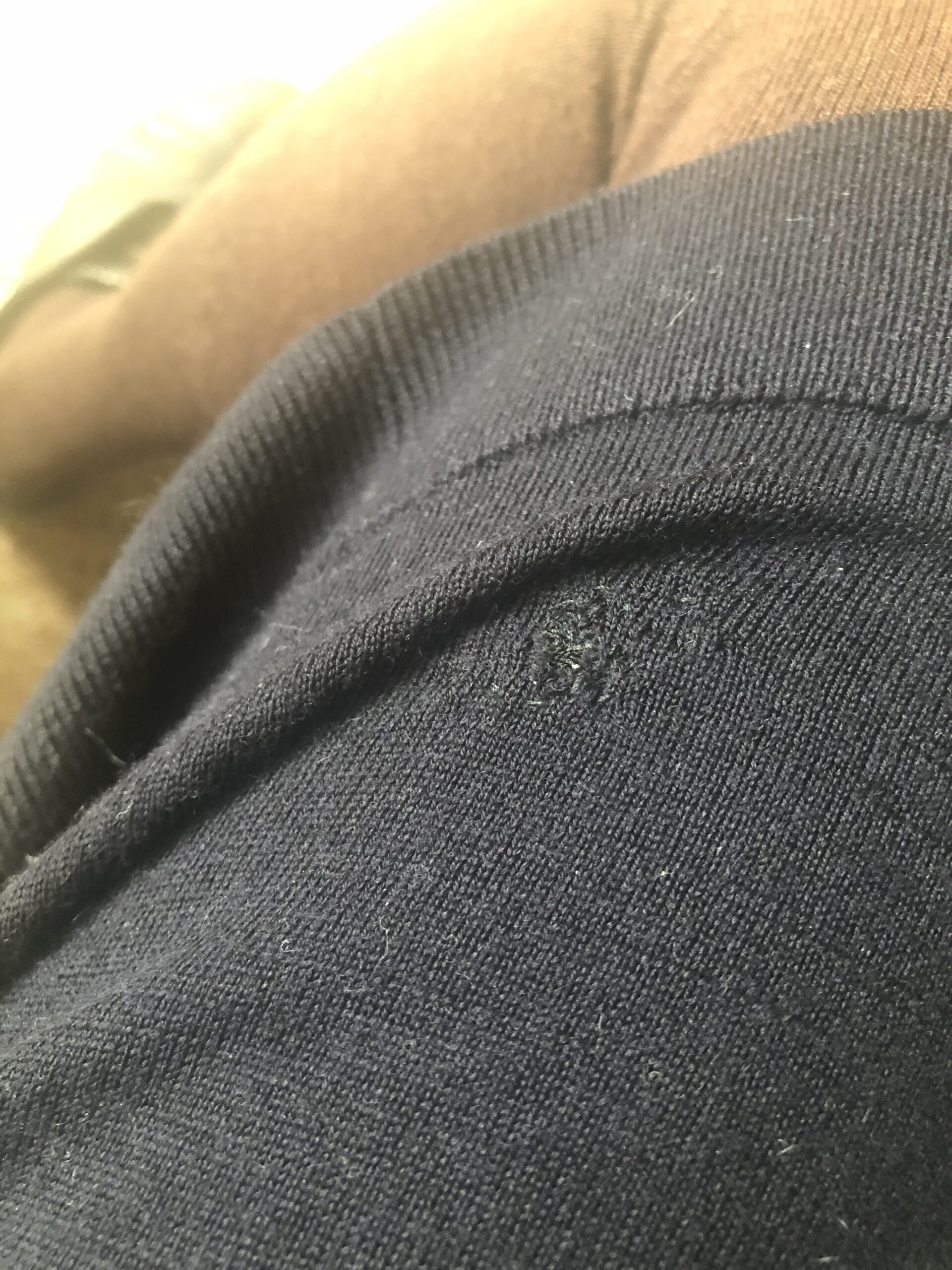
Yes, I could have mended more visibly, more creatively, but much of this dress’s appeal is its classic ease, and I didn’t want to detract from that. The stitching is neither beautiful nor invisible, but this was a quick fix so there was no languishing for weeks in a mending basket. And because the stitches are dark on dark, they’re not noticeable in the wearing.
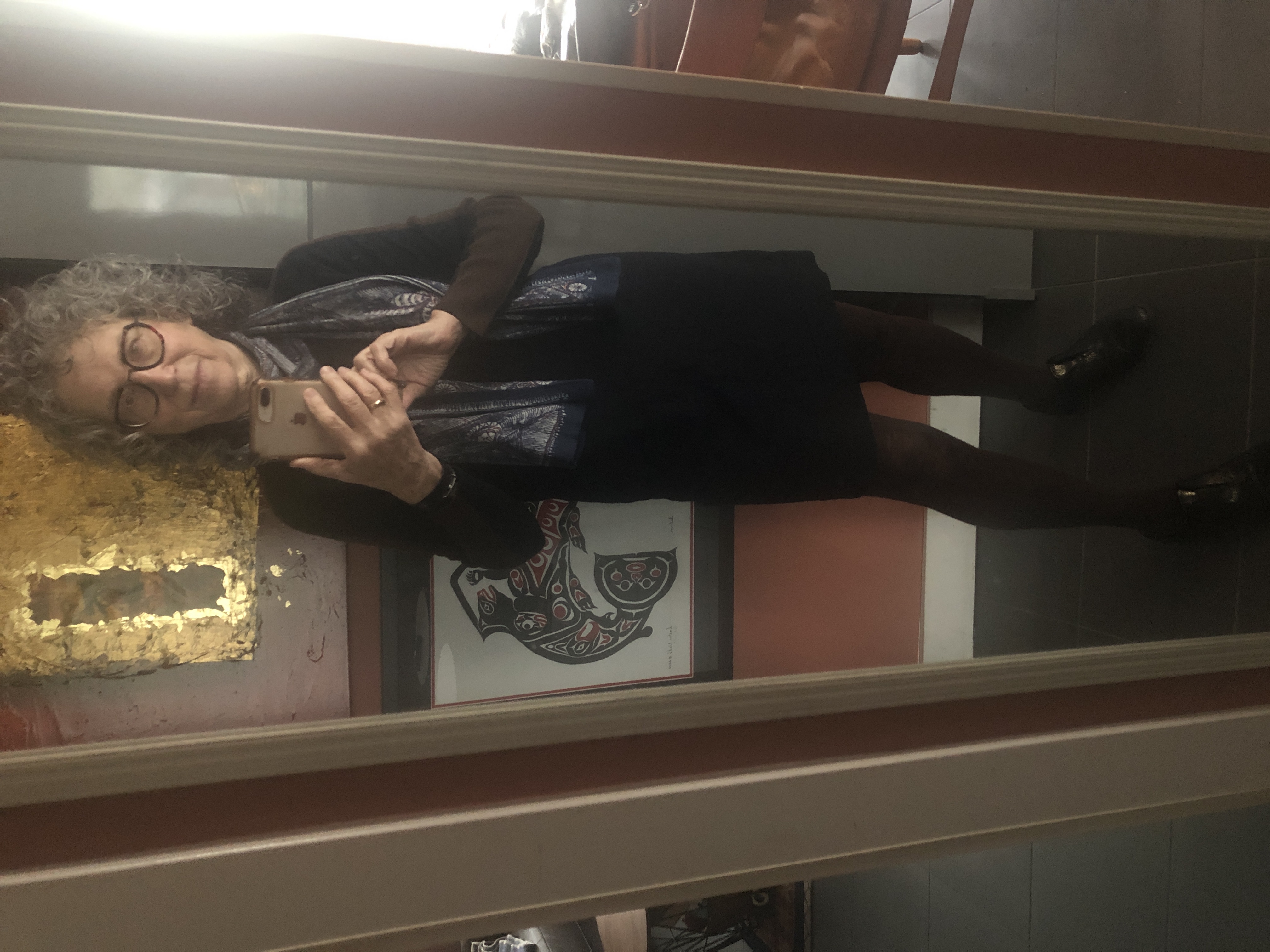
Worn here with dark brown tights, my metallic Oxford flats, and a light wool scarf I borrowed from his side of the closet. My own grey curls. . .
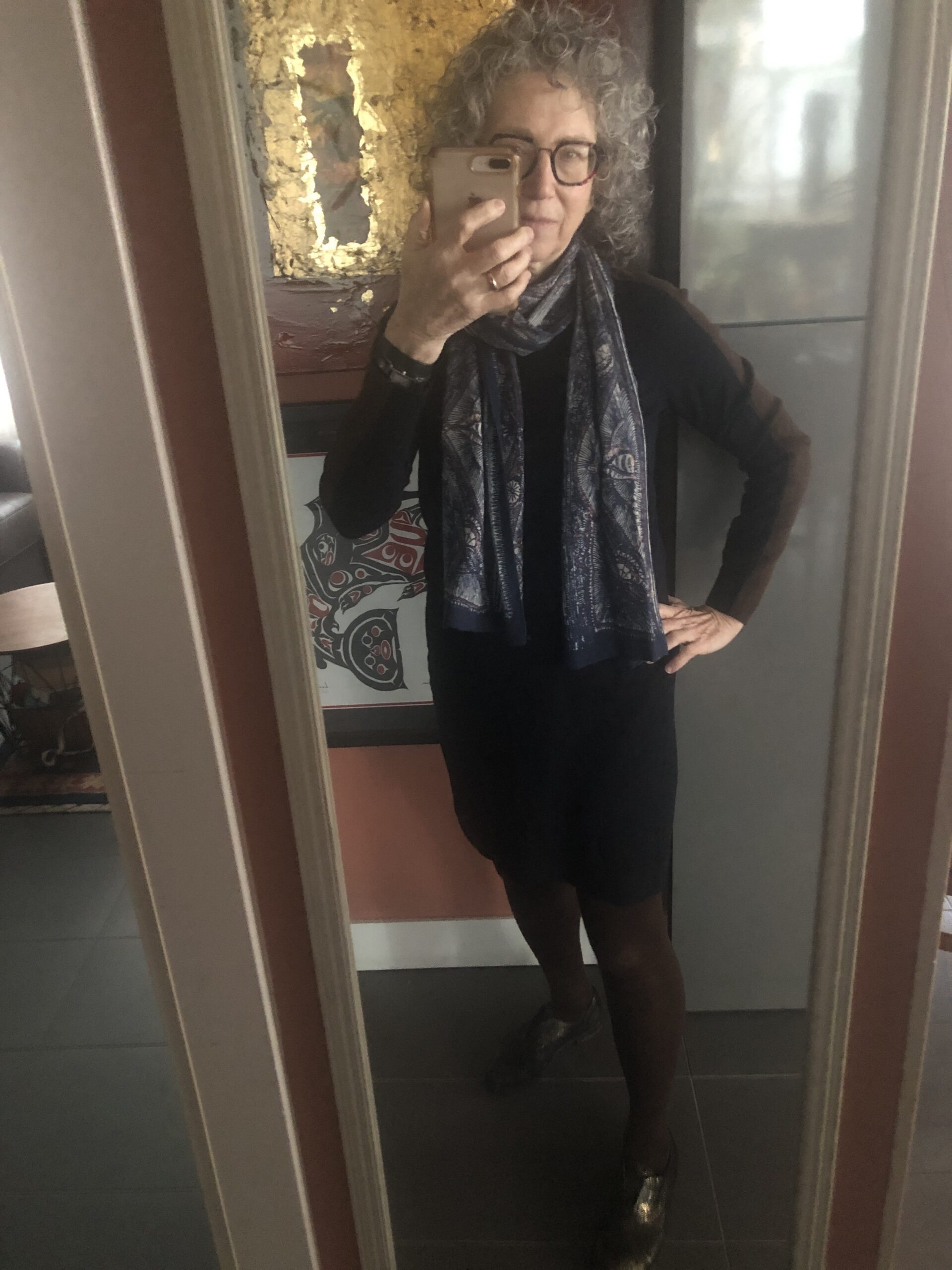
I have one more mended garment to share and a few more quotations, but I think I’ll save those for another post.
Instead, the little anecdote I promised.
Our Ten Eleven (whoops!) was over this weekend, early, by a few hours, for a big family dinner we hosted featuring the two tourtières leftover from my Christmas baking. She was curled up next to me on the couch, letting me read to her from a delightful children’s book I’d treated myself to (another Christmas leftover, I’d bought it while shopping for gifts) — The Adventures of Miss Petit-Four by Canadian poet and novelist Anne Michaels.
As we snuggled and read, H took my hand, pulled it close to her and lifted it towards her face for closer examination, “Nana, that’s so cute! You have freckles all over your hand!”
I laughed, of course I laughed, charmed and amused by this perception — and I explained about “age spots,” and showed her that they followed a few paths up my arms and told her that they’d spread pretty indiscriminately over my ageing body. Told her that some women chose to have them removed or lightened, but that I wasn’t bothered by them, was rather fascinated, in fact, to see my hands begin to resemble my mother’s as hers were in later life, and before hers, my grandmother’s.
She listened thoughtfully to all this, counted through the generations and speculated when her mother — and some day, her own self, would have freckled hands to complement their freckled faces (they’re both redheads, so that’s not as big a stretch of the imagination).
And she decided that in the meantime, my spots would henceforth be known as “Nana’s Freckles.”
I didn’t mind having them before her perception-changing observation, but I’m downright fond of my hand freckles now!
If I tell you that The Adventures of Miss Petit-Four includes a delightful explanation of the word “digression” for its young readers — illustrated amusingly by an aptly wandering paragraph or two — you might imagine you can see its influence in this post. You might not be wrong. But then again, you might point out that I was quite capable of digressing even before that influence.
Stopping here, no more digression today. Pater’s just called to say his meeting’s over, he’s walking home, and would I like to meet him for an early dinner in the neighbourhood. So I have to run. Pronto! But I’ll be back later to read any comments you care to leave. Mic’s open — let’s chat!
I read Suleika Jaouad’s memoir two years ago, but the passage that you quoted really resonated with me today. Five days from now, I’ll be undergoing a treatment that is meant to destroy a large cancerous tumour on my liver. I have no idea how successful it will be or what I’ll feel like afterward, but I’ve been warned about nausea and fatigue. I very much like Jaouad’s concept of survival as a creative act and the idea that we can make the most of whatever time we have whether it be just a few functional hours a day or a shorter lifespan that we had hoped for.
Author
Thanks so much for sharing this, Elaine — that kind of sharing seems a creative choice to me, a willingness to be vulnerable at a difficult time. I will hold you in my thoughts over the next week — may you be well. . . xo
Sorry to butt in on your conversation with Frances. Just wanted to wish you well, Elaine. I too will be holding you in my thoughts.
All the best Elaine!
Dottoressa
Thank you, my sweet blogosphere friends! The treatment went well today and I’m spending the night at our son’s house in the city before heading for home tomorrow. I’m taking it easy, and will be for awhile, but I’m feeling reasonably well and hope that that continues.
Author
Thanks for letting us know, Elaine! I’m so glad to hear that the treatment went well. Also glad to hear that you’re taking it easy. I wish you a steady, gentle recovery—take care! Xo
Best wishes Elaine.
Francis, I love your granddaughters take on your age spots…Nanas Freckles! I now smile when I look at my own ‘freckles’. Thank you
Author
Nana Freckles ‘R Us! 😉
I’m still trying to articulate my thoughts on the ageing topic and might come back later if I can get them into some kind of order.
But! In case I don’t, I want to say how nice it was to wake up this morning and find this in my inbox…your digressions are perfect, it’s absolutely like in-person conversation, happily wandering from one thing to another…thinking/wearing/eating/family. (Oh-oh. As I typed that it dawned on me that maybe I’m enjoying all the written communication from ‘home’ a bit more than usual. This is a long stretch of living externally in another language/culture. I like it a lot but it works the muscles. But for fear this itself is a digression, I’ll add this could be the kind of brain work the experts suggest is good for us as we age.) 🙂
Author
Oh, I’m tickled to hear this — even if you mainly enjoyed the post as momentary respite from Italian — which, yes, I’m quite sure is exactly that kind of brainwork. Ora, vai avanti con il tuo italiano! Vai!
I often look at my hands – with their own freckles – and marvel at how they are like my mother’s. No idea when this came about. When I was very small, I used to be impressed at how my mum could wring out a dishcloth so it was really dry and mentally decided that when I could do that, I was a real grown-up. Oddly, now that I do this all the time, this thought comes to mind. So I must be grown-up now, mustn’t I?
Oh yes, it was my grandmother’s hands for me. Used to wringing out heavy towels and blankets in the days before washing machines or dry cleaning, twisting the heavy Seine nets from my grandfather’s steam drifter, and as a young woman packing the herring she’d gutted into a barrel of brine, her fingers bound in strips of cloth against cuts from the gutting knife. My hands look effete in comparison.
Author
I love that glimpse into a child’s vision of what it means to be grown-up. Now I want to survey my grands to see what the standard is for them.
My niece at the age of about 6 told me I had “lovely young elbows” unlike her mother’s “old rough ones”. Her mother is younger than me – I gave her a bottle of body lotion for her birthday!
Author
Oh, that’s hilarious!
Do you remember a TV commercial from perhaps the 70s in which a beautiful woman was slathering a product to repair her “ugly little elbows.” Funny how that’s always stuck with me — from what I remember it was the play/tension between her evident beauty and this claim of ugliness that captured my attention.
My first thought on seeing the red stripe of mending on the jacket was that it looks like the French Légion d’honneur red thread stripe from the buttonhole to the edge of the lapel on the holders’ suit jackets.
I’m continuing to feel reticent about Athill’s casting of retirement home life as “rather pleasant” – or at least the sitting and thinking part. The main blockage for me is that from her photos at least she was very obviously not struck down by dementia or complete physical collapse, and I think I recall her saying that she was able to go out and about in London to the theatre and so on. It may well be a matter of urban versus rural. If someone as mobile at Athill was in a retirement home anywhere near me, they would be getting around either by means of private hire taxi (£40 for a 10 mile journey to the nearest town), or the public bus service which has one bus an hour during the day, virtually nothing in the evening, and no seats or shelter at most of the bus stops. The only examples I know of creativity in retirement homes are the sad sessions of enforced “crafts” or ordeal by communal sing-songs. I really don’t mean to negate what you’re trying to look at positively, and possibly prepare for, but I do feel that I’m inhabiting a different planet to Athill. In the UK most places outside metropolitan London are on that very different planet. So I feel that the potential for retirement home life to be rather pleasant is at the far end of a narrowing scale of “nots” – not cognitively impaired, not unduly physically limited, not strapped for cash, not living in an area with no significant choice of care provision. Of course we all hope that we will hold out against the first two of these, and it’s sensible to be doing all we can now to stave these off.
Author
You absolutely don’t need to agree with Diane Athill nor even with my admiration of her.
I can imagine how worrisome it must be for those of you living so far from adequate services from elder care and don’t mean to minimize that at all.
Take care.
Love that phrase Nana’s Freckles ! They are seriously a much better and almost “perfect” description of those spots that used to be known as age or liver spots. Well done “10” I salute you…
Leslie
Hostess of the Humble Bungalow
Digression can be a gift, especially in the (freckled) hands of such a wonderful writer. So many rich themes here, but I’ll start with mending. I love the whimsy of the red stitching on the pea coat and the restraint of the patch on the beautiful COS dress. Both are valid approaches to mending and valuable qualities in life. I have a beautiful and much-loved cashmere scarf that is languishing in my own mending basked because I’ve been unable to decide which path to take. I think whimsy will win but I’m unsure if my sewing skills are up to achieving a result I’ll like.
Thank you for writing about Jaouad’s and Kahlo’s use of creativity to manage pain and illness. I knew nothing about the former and little about the latter, and my interest has been piqued. Learning or studying are, of course, other well-recognised ways to respond to illness or old age. I recently embarked on an Italian language course after deciding against improving my French or starting art classes (the class I wanted didn’t proceed because of insufficient numbers). And the Italian class has become a weekly joy. However, more creative pursuits still call. Perhaps I’ll pick up some pencils or pastels over the Easter break.
Author
The problem I’ve found with waiting too long to do a “proper mend” is that the moths take advantage of my procrastination and then there’s even more mending to do! The best way to keep the moths at bay seems to be keeping the garments in fairly regular circulation — so I say, Just Go To, your stitching will get the scarf back around your neck, right?
And Brava on the Italian! E divertente, imparare, davvero?
Si, sicuramente!
Loved the excerpt from Suleika Jaouad. I found my time with chemo and radiation to be quite isolating – everyone else off and doing their things while I had to be quite isolated to avoid infection. I turned to audio books and creative embroidery to pass the time and immensely enjoyed both. The creative world took my mind off something ugly and became a place of healing and peace for me.
Author
It’s hard to read about ordeals like Suleika’s and like yours, but encouraging that some of you are able to find relief and sustenance in creative acts of making or listening. I hope all is well with you now.
I like the little red repairs . I have this vision of you waiting until Paul leaves home to grab your needle & thread to do your handiwork on his favourite coat . Like a little mouse but constructive rather than destructive . Except you are so NOT a little mouse . Quite the opposite .
Author
I’m tickled to be thought of as a constructive (and rather sly) little mouse! 😉
Thank you!
That COS dress is so lovely, Frances. I’m glad you caught the small hole before it became a problem. That dress is a keeper. Your thoughts on Diana Athill have inspired me to order some of her books from the library. I loved the article you linked to in your last post. Athill is so wise. I think if my sisters and I had given my Mum time to process the idea of living in a care home instead of wisking her home at the first sign of her protest… she might have had more quality of life in her last year. And perhaps not been so angry at me for the last months of her life. 🙁
Author
Thanks, Sue! Yes, I’m glad I stopped that hole from growing!
And very interesting observation about your Mum — I have some thoughts about this from my own experience with my mom and my MIL, and they echo yours. I’m trying to open myself to possibilities. . . That late-stage anger can be bruising!
Again, what you have shared, Frances, and the ensuing comments and dialogue are treasure trove of thinking and sharing. This in turn has my heart and mind fully engaged. And the creative mending is fabulous.
The American Symphony documentary so touched my heart when we watched it a few months ago. Thank you for reminding me of that.
And thanks for the new name for age spots—Nana’s freckles suits me too.
Author
Aw, thanks, Linda! — and wasn’t that a beautiful documentary?! I didn’t watch the Oscars last night and don’t really regret except that I would have liked to watch him perform . . .
Admire those well-earned Nana freckles! 😉
P’s coat is so,so cool! It really catches one’s eye! Brava Frances!
I’m thinking a lot about the topic….sometimes things change over night and one is never prepared enough….alghough I try to plan and be prepared and think about it
The best is to keep marching along (when,if and how is possible),to live every day and be mindful/creative every possible minute
Dottoressa
Author
Yes! With this topic, I find, too, that things can change so quickly, not just one’s own circumstances or personal health, but also — depending on what’s going on beyond us or our personal energy levels — our perspective on all this.
And yep! “Just keep swimming” (to quote a little movie fish 😉 . . . and cultivate mindfulness/creativity wherever/whenever we can. Seems to me this is the way you live! xo
Thank you for this thoughtful post and sharing Suleika Jaouad’s words. Thinking about Jaouad and Athill gives me optimism that there are ways to approach aging and illness. I like the idea of working on creativity and employing it when we don’t have the energy to get out and about.
Sweet fixes to your husband’s coat. I like the red. And your dress looks great. When I saw the closeup of the repair, I guessed that it wouldn’t be noticeable.
I’m working on a sewing project when I need a break from my knitting. I’m going to open up seems in an oversized embroidered cotton top that I use as a beach coverup and add pockets. At least, I hope to do that. I’ve cut the pocket shapes and may need to adjust them a bit. I’m sewing by hand, because I’m too lazy to pull out my heavy sewing machine and I find hand sewing to be relaxing. Fingers crossed that this plan works.
Author
Oh, good for you Dottie! So you’re putting internal pockets at the side seams –that’s going to make your beach coverup SO much more useful, right? I haven’t done hand sewing that way for ages and ages, but I so relate to what you say about pulling out the sewing machine. Mine’s not that heavy, but in the condo, I have to clear a space for it and the set-up and clear-away are always a deterrent.
There is so much to be said for mended garments that become more beautiful and original in their repair than in their purchased perfection. Creativity, at the very least creativity in how we allow ourselves to see the world and change that perspective over time, seems essential, to me. Your posts add to my life.
Author
Thanks, Lisa. Yes, I agree with your thoughtful addition to the conversation. I hope that we can normalize wearing mended garments and recognize the beauty that their mending offers, beyond the garment itself. . .